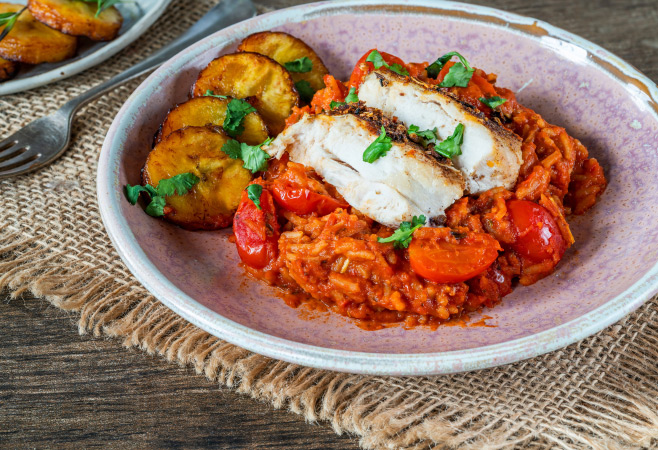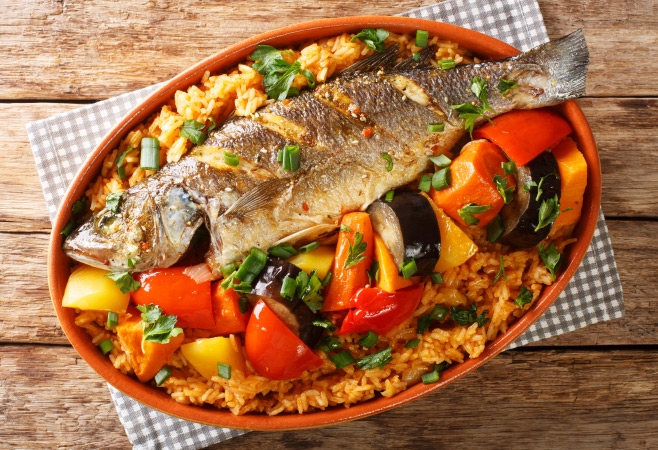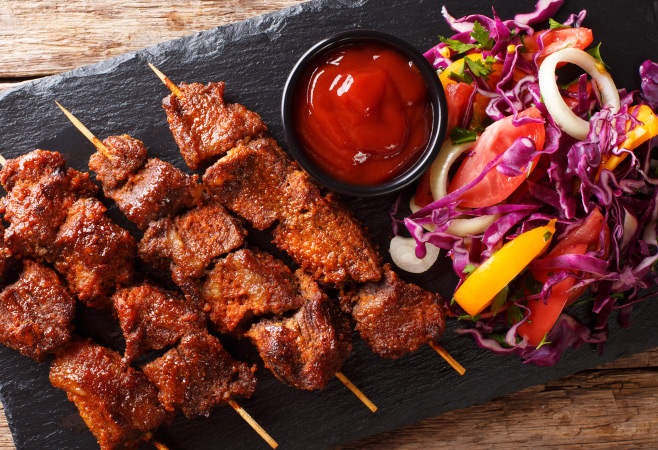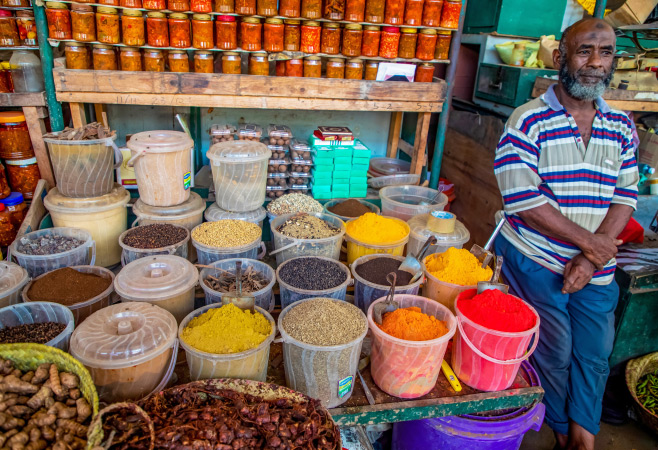Must-Try Traditional West African Foods for First-Time Visitors
Traditional West African food is a vibrant, hearty cuisine centered around staple starches (like rice, yam, cassava) served with rich, flavorful stews and soups. Expect bold spices, the distinctive taste of palm oil, and a strong emphasis on communal dining.
What Is Traditional West African Food?
Traditional West African food refers to the local dishes, cooking techniques, and ingredients commonly found across countries like Nigeria, Ghana, Senegal, Côte d’Ivoire, and Mali. Meals are often built around grains (like rice and millet), starchy vegetables (like yams and cassava), and flavorful sauces made with local spices and oils.
What Are the Most Popular Traditional West African Dishes?
Ready to explore the flavors? Here are some iconic must-try West African Dishes
Jollof Rice
Country: Nigeria, Ghana, Senegal, etc.
This is the iconic West African rice dish. Rice cooked in a rich tomato, pepper, onion, and spice base, often with chicken or beef. The smoky flavor and vibrant color are instantly recognizable.
 Jollof Rice is a traditional West African food
Jollof Rice is a traditional West African food
Maafe (Peanut Stew)
Country: Senegal, Mali, Gambia
A hearty and savory stew made with a rich peanut butter base, often including meat (beef or lamb) and vegetables like carrots, potatoes, and sweet potatoes. It's incredibly comforting.
Akara (Bean Fritters)
Country: Nigeria, Ghana
Deep-fried fritters made from peeled, blended black-eyed peas are often served as a breakfast item or snack.
Thieboudienne (Ceebu Jën)
Country: Senegal
Senegal’s national dish is a one-pot meal of rice, fish, tomato sauce, and vegetables like carrots, cabbage, and cassava.
 Experience Thieboudienne West Africa dish
Experience Thieboudienne West Africa dish
Banku / Tuo Zaafi with Okro Soup
Country: Ghana
Banku is a fermented dough of corn and cassava, while Tuo Zaafi is made from corn or millet flour. Both are served with a slippery, nutritious okro (okra) soup, often with meat or fish.
Fufu and Soup (Various Soups)
Country: Ghana, Ivory Coast
Fufu, a soft, dough-like ball made from pounded yam, cassava, or plantain, is eaten by tearing off a piece and scooping up a rich, flavorful soup.
Popular soups include Egusi Soup (melon seed soup), Peanut Soup (groundnut soup), and Light Soup.
Suya
Country: Nigeria, Niger, Cameroon
Deliciously spiced grilled skewers of meat (beef or chicken), marinated in a blend of groundnut paste and various spices. A popular street food snack.
 Suya cuisine—traditional West African food is as diverse as the land it comes from
Suya cuisine—traditional West African food is as diverse as the land it comes from
What Are the Key Ingredients in West African Cooking?
What makes West African cuisine so distinctive? It's the unique combination of these core elements:
Palm Oil
Thick, reddish oil made from palm fruit. It adds a distinct earthy flavor and bright color to stews and soups.
Chili Peppers
West African food tends to be spicy. Fresh and dried chili peppers are used generously in almost every dish.
Tomatoes, Onions, Garlic, and Ginger
These form the base for most sauces and stews.
Groundnuts (Peanuts)
Used in sauces like Groundnut Stew, or as a crust for dishes like Suya. They add creaminess and protein.
Starchy Vegetables
Think yam, cassava, plantain, and cocoyam—these are filling, versatile, and often served boiled, fried, or mashed.
 Traditional West African food is made from bold spices and deep flavors
Traditional West African food is made from bold spices and deep flavors
Experiencing West African Cuisine
Trying traditional West African food is more than just eating; it's a cultural immersion.
Communal Eating
Many meals are traditionally eaten communally from a large platter, symbolizing sharing and togetherness. You might use your right hand to scoop up the fufu or rice with the accompanying soup.
Street Food vs. Restaurants
Street Food: Explore bustling markets for delicious and affordable snacks like Suya, Akara, or roasted plantain. It's a vibrant experience.
Restaurants: From casual local eateries to more upscale establishments, you'll find places serving hearty stews and staple dishes.
Quick View About West African Food
How Do West Africans Eat?
Meals in West Africa are often communal, with families and friends sharing from a single large bowl. Most traditional foods—especially dough-like staples such as fufu—are eaten by hand. Washing hands before and after meals is a sign of respect and preparation.
Is West African Food Spicy?
Yes, but it’s all about balance. Common ingredients like chili peppers, ginger, and local spices bring heat, but fresh vegetables and starchy bases help mellow it out.
Is West African Food Healthy?
Yes—when prepared traditionally, West African food is nutrient-rich and balanced. It includes:
- Plenty of vegetables
- Lean proteins
- Whole grains and fiber
- Natural spices and herbs
Any Tips for Trying West African Food?
If you’re new to this cuisine, here’s how to dive in:
- Start with Jollof Rice—it’s flavorful and beginner-friendly.
- Don’t be afraid to eat with your hands (it’s part of the experience).
Final Thoughts
West African food isn’t just delicious—it’s nutritious and represents centuries of culture and hospitality. Experience the tastes and traditions of West Africa for yourself—each meal tells a story, and every bite is an invitation to discover more.
Apply for an Ivory Coast visa and visit Africa today to enjoy West African food!
Related Articles
- Best Time to Visit Africa: A Complete Guide for Every Traveler
- Ivory Coast Visa Fingerprinting Process Explained
- Ivory Coast Birdwatching: Where Are Best Spots & Species
- Top Kitesurfing Spots in Ivory Coast: Where and When
- Ivory Coast Visa and Travel Advisory Updates for Tourists
- Ivory Coast Desserts: Must-Try Dishes for Travelers
- Top African Airports Every Traveler Should Know
- Visa-Free Travel to the Ivory Coast - Things to Know
- Top Outdoor Activities to Experience in the Ivory Coast
- Top Must-Do Activities in the Man Region You Can’t Miss
HOW CAN WE HELP?
APPLY WITH CONFIDENCE
|











